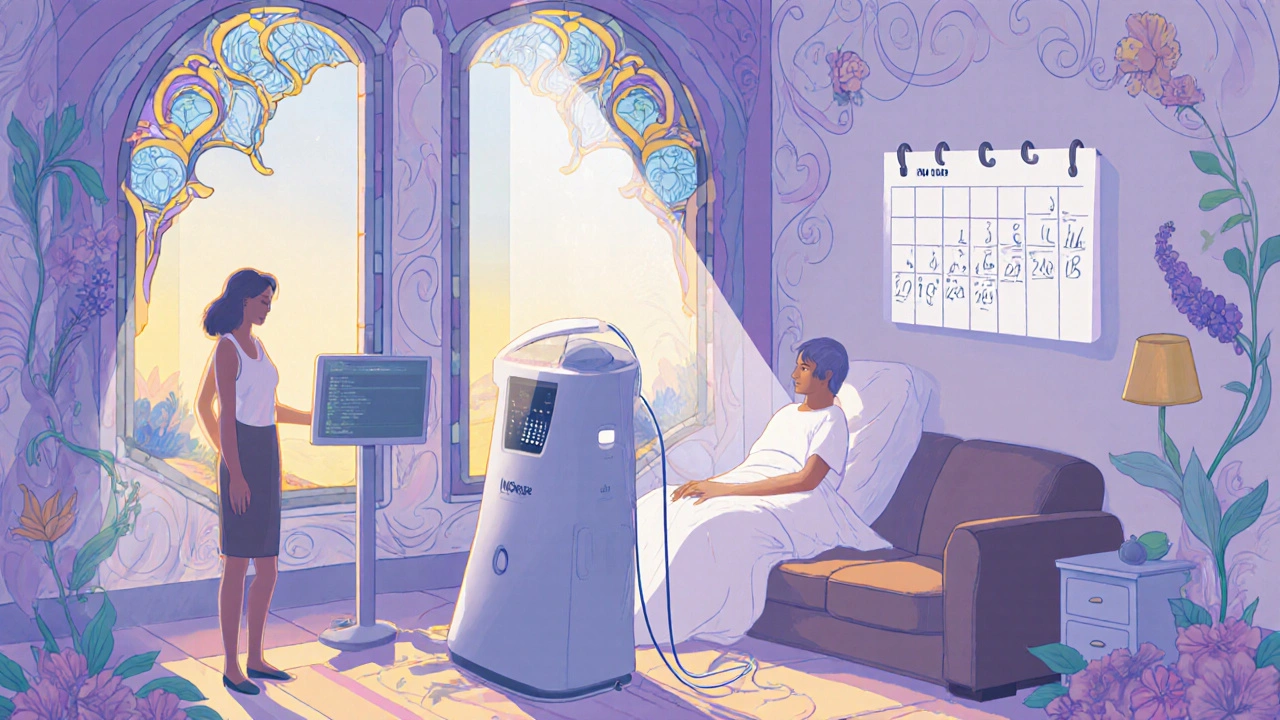Home Hemodialysis: Schedules, Training, and Outcomes

Nov, 14 2025
For someone living with end-stage renal disease, the idea of dialysis often brings to mind long hours in a clinical setting, rigid schedules, and the constant disruption to daily life. But what if you could do your dialysis at home-on your own time, in your own space, with better results? That’s the reality of home hemodialysis. It’s not a futuristic dream. It’s a proven, growing option that’s changing how thousands of people manage kidney failure every day.
What Home Hemodialysis Actually Looks Like
Home hemodialysis (HHD) means running your dialysis treatment through a machine in your living room, kitchen, or spare bedroom instead of a clinic. The process is the same: blood is pulled out of your body, cleaned by a filter, and returned. But the setting? Completely different. You control when you start, how long you go, and even when you take breaks. No more fighting traffic to get to a center at 5 a.m. No more sitting in a chair for four hours while watching TV you don’t care about. The machines used today are far more user-friendly than older models. Brands like NxStage System One and Fresenius machines are designed with safety features, automated checks, and simplified controls. You don’t need to be an engineer to run them. But you do need training. And you need a care partner.Training: It’s Not Just Learning How to Plug In a Machine
Training for home hemodialysis isn’t a quick demo. It’s a full immersion course. Most programs require between 3 and 12 weeks of hands-on learning. The average? Around 4 to 6 weeks. Some people finish faster if they’ve already practiced self-needling during in-center treatments. Others take longer if they’re dealing with vision problems, arthritis, or anxiety. You’ll learn how to:- Set up your treatment area with proper water and power systems
- Connect and disconnect your vascular access (usually a fistula or graft)
- Insert needles safely into your access-this is the hardest part for many
- Operate the dialysis machine, including priming, starting, stopping, and troubleshooting alarms
- Monitor your blood pressure before, during, and after treatment
- Calculate your fluid removal goal based on weight changes
- Store and order supplies so you never run out
- Recognize warning signs like low blood pressure, bleeding, or infection
- Document every treatment in a logbook or digital app
The Three Main Schedules: Choose What Fits Your Life
Not all home hemodialysis is the same. There are three main schedules, each with different benefits:- Conventional home hemodialysis: Three times a week, 3-4 hours per session. This looks like in-center dialysis but happens at home. It’s the easiest transition for people who want minimal change.
- Short daily home hemodialysis: Five to seven times a week, 2-3 hours per session. This is where the real clinical advantages show up. Studies show patients on this schedule have better blood pressure control, less left heart strain, and a 28% lower risk of death compared to in-center dialysis.
- Nocturnal home hemodialysis: Done while you sleep, 3-7 nights a week, 6-10 hours per session. This gentle, slow cleaning removes more toxins and fluid than any other method. Patients often report feeling more energized during the day. One study found they cut their phosphate binder pills by an average of 3.2 per day.
Outcomes: Why More People Are Switching
The data doesn’t lie. Home hemodialysis patients live longer and feel better. According to the U.S. Renal Data System, home hemodialysis patients have a 15-20% lower mortality rate than those on in-center dialysis-even after adjusting for age and other health conditions. That gap widens even more for those doing short daily or nocturnal treatments. Quality of life scores are 37% higher for home patients. Why? Because they’re not wasting 10-15 hours a week traveling to and from clinics. They’re sleeping better. Eating more freely. Traveling more easily. One Reddit user summed it up: “I’ve saved over 500 hours a year. That’s more than 12 full weeks. I’ve watched my kids grow up, not sat in a chair.” Clinically, home dialysis removes more phosphorus, clears toxins more completely, and keeps fluid balance stable. That means fewer hospital visits, less heart stress, and less need for medications. One 2018 study found nocturnal patients had 42% lower serum phosphate levels than those on standard dialysis.What You Need at Home
You can’t just plug a dialysis machine into any outlet. There are real setup requirements:- Space: You need a 6x6 foot area for the machine, supplies, and water system. No clutter. Clean, dry, and easy to sanitize.
- Water: Your home water must go through a reverse osmosis (RO) system. This isn’t a filter-it’s a medical-grade purification unit that removes chemicals, bacteria, and minerals. Monthly water and dialysate cultures are required by law.
- Power: A dedicated 120-volt, 20-amp circuit. No extension cords. No sharing with the fridge or microwave.
- Drain: A floor drain or special sink connection to handle waste fluid.
- Supplies: You’ll need dialysate solution, needles, tubing, and disinfectants. Ordering and storing these is part of your daily routine.
The Care Partner Requirement: A Double-Edged Sword
Here’s the hard truth: you cannot do home hemodialysis alone. At least not legally in most places. The Maryland Department of Health and nearly every major program require a trained care partner to be present during every treatment. That partner learns everything you do. They help with needle insertion, monitor for bleeding, respond to alarms, and call for help if something goes wrong. It’s not optional. It’s safety. But this creates a major barrier. About 30% of people who want to go home can’t find someone willing or able to help. Spouses get tired. Adult children live far away. Friends can’t commit. That’s why some centers are exploring solo home dialysis with advanced safety tech-but it’s still rare, expensive, and not covered by Medicare in most cases. The emotional toll can be heavy. One survey found 41% of home dialysis patients reported strain in their relationship with their care partner. It’s a big responsibility. It changes family dynamics. That’s why psychological readiness is just as important as technical skill.
Barriers to Wider Use
Despite the benefits, only 12% of U.S. dialysis patients use home hemodialysis. Why?- Not offered: Only 12% of dialysis centers in the U.S. even have home training programs.
- Training capacity: 71% of nephrologists say their clinics don’t have enough staff to train more patients.
- Reimbursement: Medicare pays for training, but the time and labor costs for clinics are high. Many don’t see the financial return.
- Self-needling fear: Nearly half of trainees struggle with inserting needles. Virtual reality simulators are helping-University of Washington’s program cut training time to 3-4 weeks and boosted competency to 92%.
What Patients Really Say
On forums like the American Association of Kidney Patients, people share raw, honest stories. One woman wrote: “I used to dread Mondays, Wednesdays, Fridays. Now I dialyze Tuesday, Thursday, Saturday mornings. I pick my kids up from school. I cook dinner. I sleep through the night.” But another said: “The alarms go off at 3 a.m. My husband is exhausted. We fight about who forgot to order supplies. I miss the nurses.” The most common praise? Flexibility and energy. The most common complaints? Machine alarms, supply management, and partner stress.Is Home Hemodialysis Right for You?
It’s not for everyone. But if you’re tired of the clinic grind, want more control, and have someone who can help-you should at least ask. Talk to your nephrologist. Ask if your center offers home training. Ask about the schedule options. Ask about the care partner requirement. The biggest mistake? Waiting until you’re desperate. The best candidates are those who start early-before they’re too weak, before their heart is too damaged, before they’ve lost hope. Home hemodialysis isn’t just a treatment. It’s a lifestyle shift. And for many, it’s the difference between surviving kidney failure-and truly living with it.Can you do home hemodialysis alone?
In nearly all cases, no. Most U.S. programs require a trained care partner to be present during every treatment for safety. Solo home hemodialysis is possible with advanced machines and special approvals, but it’s rare, expensive, and not covered by Medicare in most places. The requirement for a partner is a major reason why many patients don’t qualify.
How long does home hemodialysis training take?
Training typically lasts 3 to 6 weeks, but can range from 3 to 12 weeks depending on your health, learning pace, and whether you’ve practiced self-needling before. Medicare covers up to 25 training sessions. Programs that use virtual reality simulators for needle training have reduced training time to as little as 3-4 weeks with higher success rates.
What’s the difference between short daily and nocturnal home hemodialysis?
Short daily hemodialysis means 5-7 treatments per week, each lasting 2-3 hours, done during the day. Nocturnal means 3-7 treatments per week, each lasting 6-10 hours, done while you sleep. Nocturnal is gentler, removes more toxins, and improves sleep quality. Short daily is easier to fit into a daytime routine and improves blood pressure and energy faster. Both offer better outcomes than conventional dialysis.
Do you need special plumbing or electricity at home?
Yes. You need a dedicated 120-volt, 20-amp electrical circuit, a reverse osmosis water system (not a regular filter), a floor drain or special sink connection for waste fluid, and a water supply line with 40-80 psi pressure. These are non-negotiable for safety and machine function. Your clinic will assess your home before approving you for home therapy.
Is home hemodialysis cheaper than in-center?
Medicare pays the same amount whether you do dialysis at home or in a center. But for patients, home dialysis often saves money indirectly-no travel costs, less need for blood pressure or phosphate medications, fewer hospital visits, and no lost wages from missing work. The upfront cost of home setup (RO system, plumbing) is usually covered by insurance or the clinic.
Can you travel with home hemodialysis equipment?
Only if you have a portable machine like the NxStage System One. Standard home dialysis machines are too large and require fixed plumbing and power. Portable units can be packed and shipped, but you must plan ahead: arrange for water delivery, bring backup supplies, and coordinate with dialysis centers at your destination. Traveling with a standard machine is not practical.
What are the biggest risks of home hemodialysis?
The biggest risks are infection at the vascular access site, bleeding from needle insertion, low blood pressure during treatment, and machine malfunction. Without immediate help, these can become serious. That’s why training and a care partner are mandatory. Most complications are preventable with proper technique and quick response. Patients who stick to their training logs and report problems early have the fewest issues.
How do you know if you’re a good candidate for home hemodialysis?
Good candidates are motivated, mentally and physically able to learn the procedures, have a stable care partner, and have a clean, safe home setup. You don’t need to be perfect-you just need to be willing to learn, follow rules, and communicate openly with your team. The most successful patients aren’t the healthiest-they’re the ones who ask questions, show up for training, and don’t give up when it gets hard.
